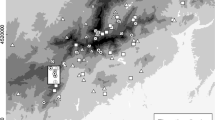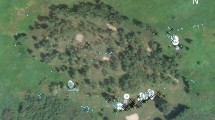Abstract
The False Ringlet (Coenonympha oedippus) is a European butterfly species, endangered due to the severe loss and fragmentation of its habitat. In Hungary, two remaining populations of the butterfly occur in lowland Purple Moorgrass meadows. We studied a metapopulation occupying twelve habitat patches in Central Hungary. Our aim was to reveal what measures of habitat quality affect population size and density of this metapopulation, estimate dispersal parameters and describe phenology of subpopulations. Local population sizes and dispersal parameters were estimated from an extensive mark–release–recapture dataset, while habitat quality was characterized by groundwater level, cover of grass tussocks, bush cover, height of vegetation and grass litter at each habitat patch. The estimated size of the metapopulation was more than 3,000 individuals. We estimated a low dispersal capacity, especially for females, indicating a very low probability of (re)colonization. Butterfly abundance and density in local populations increased with higher grass litter, lower groundwater level and larger area covered by tussocks. We suppose that these environmental factors affect butterfly abundance by determining the microclimatic conditions for both larvae and adult butterflies. Our results suggest that the long-term preservation of the studied metapopulation needs the maintenance of high quality habitat patches by appropriate mowing regime and water regulation. Management also should facilitate dispersal to strengthen metapopulation structure with creating stepping-stones or gradually increase habitat quality in present matrix.


Similar content being viewed by others
References
Aistleitner U, Mayr T, Siegel C (2006) Nachweise von neuen, verschollenen und stark gefahrdeten Grosschmetterlingen aus Vorarlberg, Austria occ. (Lepidoptera). Z Arb Gem Ost Ent 58:1–10
Baguette M, Nève G (1994) Adult movements between populations on the specialist butterfly Proclossiana eunomia (Lepidoptera, Nymphalidae). Ecol Entomol 19:1–5
Baguette M, Clobert J, Schtickzelle N (2011) Metapopulation dynamics of the bog fritillary butterfly: experimental changes in habitat quality induced negative density-dependent dispersal. Ecography 34:170–176
Bálint Z, Máté A (2004) Ezüstsávos szénalepke (Coenonympha oedippus) fajmegőrzési terv. [False ringlet (Coenonympha oedippus) species conservation actionplan.] KvVM Természetvédelmi Hivatala, Budapest
Bartoš M, Janeček S, Klimešová J (2011) Effect of mowing and fertilization on biomass and carbohydrate reserves of Molinia caerulea at two organizational levels. Acta Oecol 37:299–306
Bonelli S, Canterino S, Balletto E (2010) Ecology of Coenonympha oedippus (Fabricius, 1787) (Lepidoptera: Nymphalidae) in Italy. Oedippus 26:25–30
Bourn NAD, Pearman GS, Goodger B, Thomas JA, Warren MS (2000) Changes in the status of two endangered butterflies over two decades and the influence of grazing management. In: Rook AJ, Penning PD (eds) Grazing management. British Grassland Society, Reading, pp 141–146
Bozano GC (2002) Guide to the butterflies of the Palearctic region. Satyrinae part III. Omnes Artes, Milano
Bräu M, Dolek M, Stettmer C (2010) Habitat requirements, larval development and food preferences of the German population of the False Ringlet Coenonympha oedippus (FABRICIUS, 1787) (Lepidoptera: Nymphalidae)—research on the ecological needs to develop management tools. Oedippus 26:41–51
Burnham KP, Anderson DR (2002) Model selection and multi-model inference. A practical information-theoretic approach, 2nd edn. Springer-Verlag, New York
Čelik T (2004) Population dynamics of endangered species Coenonympha oedippus Fabricius, 1787 (Lepidoptera:Satyridae) on the Ljubljansko Baarje (Slovenia). Acta Entomol Slovenica 12:99–114
Čelik T, Verovnik R (2010) Coenonympha oedippus (FABRICIUS, 1787) (Lepidoptera: Nymphalidae) in Slovenia. Oedippus 26:7–15
Čelik T, Vreš B, Seliškar A (2009) Determinants of within-patch microdistribution and movements of endangered butterfly Coenonympha oedippus (Fabricius, 1787) (Nymphalidae: Satyrinae). Hacquetia 8:115–128
Cook LM, Brower LP, Croze HJ (1967) The accuracy from a population estimation from multiple recapture data. J Anim Ecol 36:57–60
Dennis RLH, Shreeve TG, Van Dyck H (2006) Habitats and resources: the need for a resource-based definition to conserve butterflies. Biodivers Conserv 15:1943–1966
Dover J, Settele J (2009) The influence of landscape structure on butterfly distribution and movement: a review. J Insect Conserv 13:3–27
Dušej G, Wermeille E, Carron G, Ziegler H (2010) Concerning the situation of the False Ringlet Coenonympha oedippus (FABRICIUS, 1787) (Lepidoptera: Nymphalidae) in Switzerland. Oedippus 26:38–40
Erhardt A, Thomas JA (1991) Lepidoptera as indicators of change in the seminatural grasslands of lowland and upland Europe. In: Collins NM, Thomas JA (eds) The conservation of insects and their habitats. Academic Press, London, pp 213–237
Fischer K, Beinlich B, Plachter H (1999) Population structure, mobility and habitat preferences of the violet copper Lycaena helle (Lepidoptera: Lycaenidae) in Western Germany: implications for conservation. J Insect Conserv 3:43–52
Gorbunov P (2001) The butterflies of Russia: classification, genitalia, keys for identification (Lepidoptera: Hesperioidea and Papilionoidea). Dissertation, Russian Academy of Sciences, Institute of Plant and Animal Ecology
Gorbunov P, Kosterin O (2007) The butterflies (Hesperioidea and Papilionoidea) of North Asia (Asian part of Russia) in nature. Rodina and Fodio, Moscow
Halada L, Evans D, Romão C, Petersen J (2011) Which habitats of European importance depend on agricultural practices? Biodivers Conserv 20:2365–2378. doi:10.1007/s10531-011-9989-z
Hambler C, Henderson PA, Speight MA (2011) Extinction rates, extinction-prone habitats, and indicator groups in Britain and at larger scales. Biol Conserv 144:713–721
Hanski I (1998) Metapopulation dynamics. Nature 396:41–49
Hanski I (2003) Biology of extinctions in butterfly metapopulations. In: Boggs CL, Watt WB, Ehrlich PR (eds) Butterflies: ecology and evolution taking flight. University of Chicago Press, Chicago, pp 577–602
Hanski I, Glipin ME (1997) Metapopulation biology. Ecology, genetics and evolution. Academic Press, San Diego
Hanski I, Alho J, Moilanen A (2000) Estimating the parameters of survival and migration of individuals in metapopulations. Ecology 81:239–251
Hovestadt T, Binzenhofer B, Nowicki P, Settele J (2011) Do all inter-patch movements represent dispersal? A mixed kernel study of butterfly mobility in fragmented landscapes. J Anim Ecol 80:1070–1077
IUCN (2011) IUCN Red List of Threatened Species. Version 2011.2. <www.iucnredlist.org>. Accessed 15 November 2011
Joy J, Pullin AS (1996) The effects of flooding on the survival and behaviour of overwintering large heath butterfly Coenonympha tullia larvae. Biol Conserv 82:61–66
Kučinić M, Tvrtković N, Kletečki E (1999) The False Ringlet is a member of the Croatian butterfly fauna after all. Nat Croat 8:399–404
Kudrna O (2002) The distribution atlas of European butterflies. Oedippus 20:1–343
Lebreton J-D, Burnham KP, Clobert J, Anderson DR (1992) Modeling survival and testing biological hypotheses using marked animals: a unified approach with case studies. Ecol Monogr 62:67–118
Lenda M, Skórka P (2010) Patch occupancy, number of individuals and population density of the Marbled White in a changing agricultural landscape. Acta Oecol 36:497–506
Lhonoré J, Lagarde M (1999) Biogeographie, ecologie et protection de Coenonympha oedippus (Fab., 1787) (Lepidoptera: Nymphalidae: Satyrinae). Ann Soc Entomol France 35:299–307
Nowicki P, Pepkowska A, Kudlek J, Skórka P, Witek M, Settele J, Woyciechowski M (2007) From metapopulation theory to conservation recommendations: lessons from spatial occurrence and abundance patterns of Maculinea butterflies. Biol Conserv 140:119–129
Öckinger E (2006) Possible metapopulation structure of the threatened butterfly Pyrgus armoricanus in Sweden. J Insect Conserv 10:43–51
Oostermeijer JGB, van Swaay CAM (1998) The relationship between butterflies and environmental indicator values: a tool for conservation in a changing landscape. Biol Conserv 86:271–280
Örvössy N, Vozár Á, Kőrösi Á, Batáry P, Peregovits L (2010) Structure and size of a threatened population of the False Ringlet Coenonympha oedippus (FABRICIUS, 1787) (Lepidoptera: Nymphalidae) in Hungary. Oedippus 26:31–37
Parmesan C (2003) Butterflies as bioindicators for climate change effects. In: Boggs CL, Watt WB, Ehrlich PR (eds) Butterflies: ecology and evolution taking flight. University of Chicago Press, Chicago, pp 541–560
Rabasa SG, Gutiérrez D, Escudero A (2008) Relative importance of host plant patch geometry and habitat quality on the patterns of occupancy, extinction and density of the monophagous butterfly Iolana iolas. Oecologia 156:491–503
Sanford MP, Dennis DM, Brussard PF (2011) Distinguishing habitat types and the relative influences of environmental factors on patch occupancy for a butterfly metapopulation. J Insect Conserv. doi:10.1007/s10841-011-9376-9
Šašić M (2010) False Ringlet Coenonympha oedippus (FABRICIUS, 1787) (Lepidoptera: Nymphalidae) in Croatia: current status, population dynamics and conservation management. Oedippus 26:16–19
Sawchik J, Dufrêne M, Lebrun P (2003) Estimation of habitat quality based on plant community, and effects of isolation in a network of butterfly habitat patches. Acta Oecol 24:25–33
Sielezniew M, Pałka K, Michalczuk W, Bystrowski C, Hołowiński M, Czerwiński M (2010) False Ringlet Coenonympha oedippus (FABRICIUS, 1787) (Lepidoptera: Nymphalidae) in Poland: state of knowledge and conservation prospects. Oedippus 26:20–24
Skórka P, Settele J, Woyciechowski M (2007) Effects of management cessation on grassland butterflies in southern Poland. Agric Ecosyst Environ 121:319–324
Stasinopoulos M, Rigby B, Akantziliotou C (2012) Instructions on how to use the gamlsss package in R. http://www.gamlss.org/images/stories/papers/gamlss-manual.pdf. Accessed 03 August 2012
Staub R, Aistleitner U (2006): Das Moor-Wiesenvögelschen (Coenonympha oedippus)—oder worauf es im grenzüberschreitenden Artenschutz ankommt. In: Broggi MF (ed) Alpenrheintal—eine Region im Umbau. Analysen und Perspektiven der räumlichen Entwicklung, Verlag der Liechtensteinischen Akademischen Gesellschaft, Schaan, pp 245–254
Sutcliffe OL, Thomas CD, Yates TJ, Greatorex-Davies JN (1997) Correlated extinctions, colonizations and population fluctuations in a highly connected ringlet butterfly metapopulation. Oecologia 109:235–241
R Development Core Team (2011) R: A language and environment for statistical computing. R Foundation for Statistical Computing, Vienna, Austria. ISBN 3-900051-07-0, URL http://www.R-project.org/
Thomas JA (1991) Rare species conservation: case studies of European butter£ies. In: Spellerberg I, Goldsmith B, Morris MG (eds) The scientific management of temperate communities for conservation. Blackwell, Oxford, pp 149–197
Thomas CD, Hanski I (1997) Butterfly metapopulations. In: Hanski I, Gilpin ME (eds) Metapopulation biology, ecology, genetics and evolution. Academic Press, San Diego, pp 359–386
Thomas JA, Morris MG (1994) Patterns, mechanisms and rates of decline among UK invertebrates. Philos Trans R Soc Lond B 344:47–54
Thomas JA, Clarke RT, Elmes GW, Hochberg ME (1998) Population dynamics in the genus Maculinea. In: Dempster JP, McLean IFG (eds) Insect population dynamics: in theory and practice. Chapman & Hall, London, pp 261–290
Thomas JA, Bourn NAD, Clarke RT, Stewart KE, Simcox DJ, Pearman GS, Curtis R, Goodger B (2001) The quality and isolation of habitat patches both determine where butterflies persist in fragmented landscapes. Proc R Soc Lond B 268:1791–1796
Thomas JA, Telfer MG, Roy DB, Preston CD, Greenwood JJD, Asher J, Fox R, Clarke RT, Lawton JH (2004) Comparative losses of British butterflies, birds, and plants and the global extinction crisis. Science 303:1879–1881
Turlure C, Baguette M, Stevens VM, Maes D (2011) Species- and sex-specific adjustments of movement behavior to landscape heterogeneity in butterflies. Behav Ecol 22:967–975
van Halder I, Barbaro L, Corcket E, Jactel H (2008) Importance of semi-natural habitats for the conservation of butterfly communities in landscapes dominated by pine plantations. Biodivers Conserv 17:1149–1169
van Swaay CAM (2002) The importance of calcareous grasslands for butterflies in Europe. Biol Conserv 104:315–318
van Swaay C, Cuttelod A, Collins S, Maes D, López Munguira M, Šašić M, Settele J, Verovnik R, Verstrael T, Warren M, Wiemers M, Wynhoff I (2010) European red list of butterflies. Publications Office of the European Union, Luxembourg
Vanreusel W, Van Dyck H (2007) When functional habitat does not match vegetation types: a resource-based approach to map butterfly habitat. Biol Conserv 135:202–211
van Swaay CAM, Warren MS (1999) Red Data book of European butterflies (Rhopalocera). Nature and Environment, No. 99, Council of Europe Publishing, Strasbourg, pp 260
Warren MS, Hill JK, Thomas JA, Asher J, Fox R, Huntley B, Roy DB, Telfer MG, Jeffcoate S, Harding P, Jeffcoate G, Willis SG, Greatorex-Davies JN, Moss D, Thomas CD (2001) Rapid responses of British butterflies to opposing forces of climate and habitat change. Nature 414:65–69
White GC, Burnham KP (1999) Program MARK: survival estimation from populations of marked animals. Bird Study 46:120–138
Acknowledgments
We would like to thank A. Máté for fieldwork cooperation and L. Sutcliffe for helpful comments and improving the language of the manuscript. This research was supported by the National R&D Programme ‘Faunagenezis’ (contract no.: 3B023-04). Á. K. and P. B. were supported by the Hungarian Academy of Sciences. During the preparation of the paper P. B. was supported by the Bolyai Research Fellowship of the Hungarian Academy of Sciences.
Author information
Authors and Affiliations
Corresponding author
Rights and permissions
About this article
Cite this article
Örvössy, N., Kőrösi, Á., Batáry, P. et al. Potential metapopulation structure and the effects of habitat quality on population size of the endangered False Ringlet butterfly. J Insect Conserv 17, 537–547 (2013). https://doi.org/10.1007/s10841-012-9538-4
Received:
Accepted:
Published:
Issue Date:
DOI: https://doi.org/10.1007/s10841-012-9538-4




